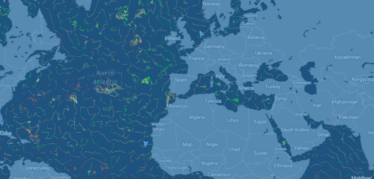2020 was marked by unprecedented challenges and changes for the maritime shipping industry. Many of these challenges persist as the COVID-19 pandemic continues to enforce a ‘new normal’ across industries and regions of the world. While certain aspects of 2021 stand in the balance, subject to the future trajectory of COVID-19, other things remain certain: like the bright and digitally-enabled future of maritime commerce.
As we so often discuss in our conversations with clients and in the content we produce, digitalization is a journey and not a destination. At its very best, it is a journey marked by continual and incremental progress that evolves in lockstep with your business realities.
As we begin a new year with new business realities, I’d like to highlight four specific goals that we see shaping maritime shipping digitalization in 2021.
- Standardize data, systems, and workflows.
Amid outsized volatility and the extended impact of the COVID-19 pandemic, scalability, financial performance, and continual improvement matter now more than ever for the maritime shipping industry. In order to realize these fundamental advantages, organizations must take steps to standardize data, systems, and workflows in pursuit of enhanced visibility and decision-ready insights across every part of their business.
Without a unified commercial solution capable of enabling this standardization, powerful insights that can drive decision-making are buried in disparate data sources, rendering them essentially useless. As we have begun to see through industry-wide digitalization efforts, bringing this data together in a cohesive way empowers maritime shipping organizations to analyze and optimize individual voyage performance and maximize their overall success. In 2021, standardization will become increasingly essential for maritime organizations to keep pace with evolving realities and capitalize on every opportunity to run a more efficient and profitable business. Furthermore, as standardization gains critical mass within individual maritime shipping businesses, the entire industry will open itself to new cross-organizational standardization opportunities.
- Harness technology to employ more sustainable practices.
Sustainability initiatives have grown in prevalence and urgency across all industries, and this is especially true of maritime shipping. In 2018, maritime shipping was responsible for 2.89% of the world’s carbon emissions. As a result, the IMO set ambitious goals to significantly reduce the industry’s environmental impact over the next few decades. While these regulatory requirements have forced sustainability into focus, the worldwide push to combat climate change has also made sustainability a focal point for maritime shipping organizations.
In order to comply with recent regulations and enhance sustainability in earnest, maritime shipping organizations require an effective way to track and analyze the environmental impact of their voyages. Technology serves as a powerful tool in minimizing maritime shipping’s carbon footprint as it enables stakeholders to accurately assess the CO2 impact of every voyage, understand how to make voyages more sustainable, and put these insights into practice. It is important to note that operational efficiency has the two-fold benefit of enhanced sustainability and profitability, so 2021 will increase focus on technologies that can help decision-makers optimize vessel and voyage performance.
- Complement and enable human efforts through automation.
As we continue to see automation play out in the form of autonomous ships and smart ports, commercial automation is beginning to find its long-term role in the business of maritime shipping. For shipowners, operators, commodities traders, and tonnage charterers, automation’s true promise lies in its ability to enhance and extend the efforts of busy workers.
The most successful forms of automation within the commercial workflow empower maritime shipping stakeholders to do their jobs more efficiently and effectively while enabling the cross-stakeholder continuity that is essential for optimizing business performance. For example, operators can harness automation to surface top-of-mind tasks and alerts based on their unique business rules, and charterers can automate the assembly of optimized schedules, then spend their valuable time making adjustments based on their unique institutional knowledge. In 2021, we will see more and more examples of automation as an enabler of key maritime shipping stakeholders.
- Narrow the distance between ship and shore, counterparty and carrier, colleague and colleague.
While COVID-19 has driven us apart in many ways, digitalization has the power to bring us closer together. Current examples of this include the digitalization of the noon report, cloud-based workspaces that enable workers to collaborate on complex estimates, and connected workflows that eliminate data gaps between core functional areas. In 2021, we will see many more examples emerge. Innovation will continue to be born out of the need to engage inside and outside of the organization.
As mentioned, many maritime shipping organizations are hindered by a lack of comprehensive visibility and control across stakeholders, resulting in inconsistencies that prevent their businesses from operating at their full potential. These challenges have only been exacerbated by the pandemic, prompting maritime shipping organizations to pursue new ways to enhance resiliency and enable greater connectivity. The need for cross-stakeholder continuity will remain top-of-mind for maritime organizations as they look for new ways to embrace digitalization in 2021.
Advance Your Digitalization Strategy with VIP
As the standard platform that propels maritime commerce, the Veson IMOS Platform (VIP) delivers a flexible suite of connected solutions to achieve your digitalization goals in 2021 and beyond. With hundreds of features added every year to support the evolving needs of the maritime shipping industry, VIP delivers the proven business logic and continuous innovation needed to keep your business ahead amid today’s dynamic and ever-changing business realities. Today, more than 18,000 professionals across more than 300 global organizations are harnessing the power of VIP to streamline their day-to-day operations and achieve their long-term business goals. We invite you to explore the future of maritime digitalization further by viewing our Digitalization Buyer’s Guide below.



 Russ Hubbard
Russ Hubbard
 Aidan Williams
Aidan Williams